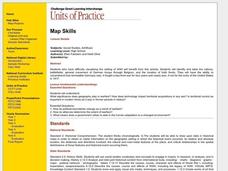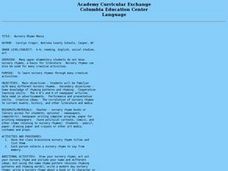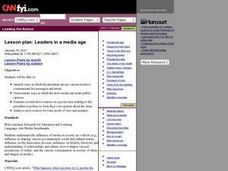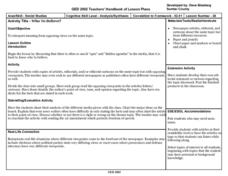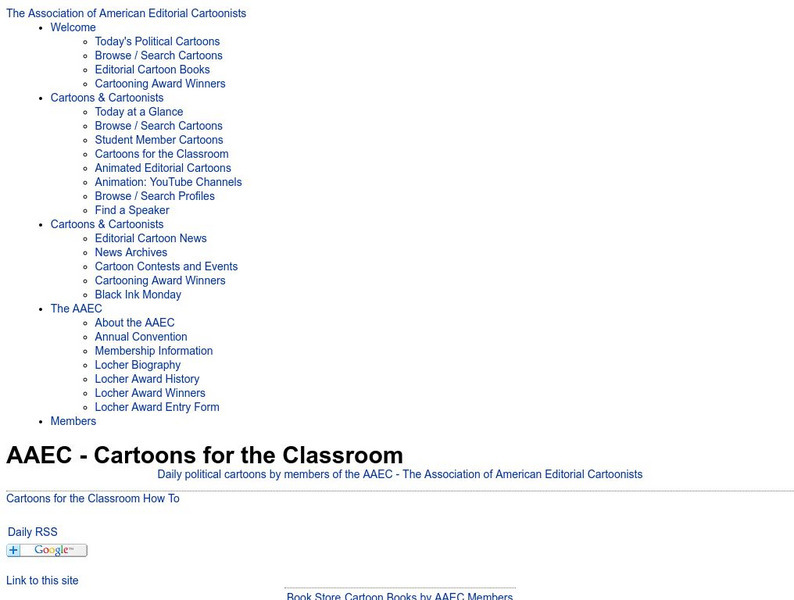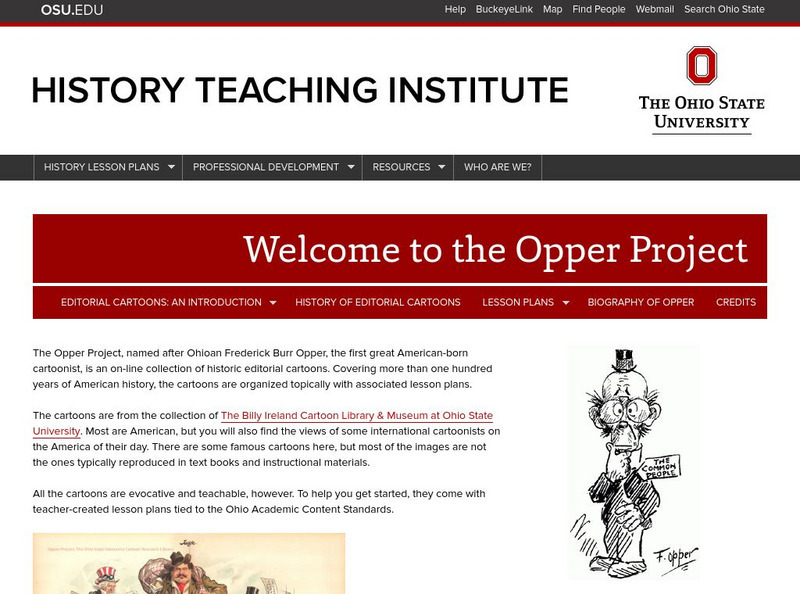Curated OER
Map Skills
Students examine the nations, battlefields, troop movement of the Germans through Belgium and the location of both fronts during World War I by creating a map. They visualize the strength of the Germans early in the war.
Curated OER
Charolotte Perkins Gilman's "The Yellow Wall-paper" - the "New Woman"
Students analyze the life of American middle to upper-class women in the mid- to late-nineteenth century and early twentieth century. In this women's suffrage lesson, students visit the given links in the lesson to analyze the changing...
Curated OER
Nursery Rhyme Mania
Students become familiar with many different nursery rhymes. They use nursery rhymes for a variety of creative activities including writing, singing, poetry and acting.
Curated OER
Working Conditions in America: 1880s versus 2000s
Learners conduct research into the life of Americans and how working conditions have changed over time from the 1880's to modern times. They use primary and secondary resources in order to compile research in order to report the findings...
Curated OER
Jazz in America
Eleventh graders explore Jazz in America. They examine greats in Jazz, such as Duke Ellington. They are also to discuss the cultural implications of the music itself.
Curated OER
The Cuban Missile Crisis
Students reflect on the events that lead up to the Cuban Missile Crisis in the early 1960s. In this history lesson plan, students explore the conflicts between the United States and the Soviet Union revolving around missiles in Cuba,...
Curated OER
Omaha Race Riot of 1919
Students analyze primary documents and images. Students organize and evaluate the causes and results of the Omaha race riot of 1919. Students study and recognize key personalities involved. Students relate history to certain quotes...
Curated OER
To War or Not To War!
Ninth graders examine the various types of propaganda used during World War II. In groups, they make notes on each example and determine why they believe the opinion of the United States involvement in the war changed. They share their...
Curated OER
Leaders in a Media Age
Students identify ways in which the president can use various media to communicate his messages and intent. They demonstrate ways in which the news media can create public opinion.
Curated OER
Virginia In the World: The Geography of Commerce
Young scholars examine how Virginia connects with the world through export trade. Using a map, they use symbols to depict the value of trade and the direction of the flow of goods. They complete a scavenger hunt using electronic almanacs...
Curated OER
Household Names
Students explore the accomplishments of famous New Yorkers in the 19th century. In small groups, students read biographies and match them with a corresponding primary source document. The group that is most accurate in matching the...
Curated OER
The Cost of Progress
Students examine the cost of progress from the 1500's to the 1800's around the world and create informative websites based upon their research. This instructional activity is intended for a high school World History class and uses the...
Curated OER
What is the Character of Maine?
Young scholars create an individual portfolio using assignments from a unit on the character of Maine. They choose two of the best assignments from each of four chapters studied and then write an essay or create a magazine which...
Curated OER
The Shot Heard Around the World
Fifth graders examine the events leading up to the beginning of the Revolutionary War. In groups, they put the events into chronological order and create a timeline. As a class, they discuss the reprecussions of the Stamp Act,...
Curated OER
The First Ladies
High schoolers compare two First Ladies. In this American history lesson, students read speeches given by Barbara Bush and Hillary Rodham Clinton. High schoolers respond to questions about the speeches.
Curated OER
Who To Believe?
Students interpret meaning from opposing views on the same topic, and discuss that there is often so much "spin" and "hidden agendas" in the media.
Library of Congress
Loc: Political Cartoons: Finding Point of View
A careful analysis of political cartoons can provide a glimpse into key moments of U.S. political history. In this activity, students will closely examine political cartoons about the Stamp Act; make inferences about the political,...
Library of Congress
Loc: Political Cartoons and Debates
A rich Web resource from the Library of Congress for lesson plans that require researching historic political cartoons and utilizing primary source documents.
Alabama Learning Exchange
Alex: Political Cartoon Analysis
Students will review and discuss how to evaluate the symbols and related meanings of political cartoons. The project will involve analyzing a current political cartoon, determining its meaning, and presenting the information to the class.
US National Archives
National Archives: Representing Congress: Clifford Berryman's Political Cartoons
Political cartoons have informed the public and sparked debate throughout history. This ebook contains political cartoons pertaining to Congress. Students will understand the powers and responsibilities of Congress by analyzing these...
Newspapers in Education
Ni Eonline: Cartoons for the Classroom: Lessons Library
Newspapers in Education and the Association of American Editorial Cartoonists publish simple, inventive lesson plans and ideas for classes in editorial cartooning, caption writing, and news analysis. Lessons include "cartoon blanks" that...
Stanford University
Sheg: Document Based History: Reading Like a Historian: Political Bosses
[Free Registration/Login Required] Young scholars use primary source documents to investigate central historical questions. For this investigation, students examine a political cartoon, a muckraker text, and the defense of a political...
Smithsonian Institution
Smithsonian Libraries:drawing From Life: Caricatures and Cartoons
A website dedicated to displaying a selection of political cartoons and caricatures from the nineteenth and twentieth centuries. Includes biographies of many famous cartoonists and commentaries on the cartoonist's style and interests.
Ohio State University
Opper Project: Using Editorial Cartoons to Teach History (Lesson Plans)
Two dozen lessons that focus on using political cartoons as primary source resources for teaching American history. Lessons cover a range of topics in U.S. history from the Civil War era forward and are linked to Ohio content standards.


